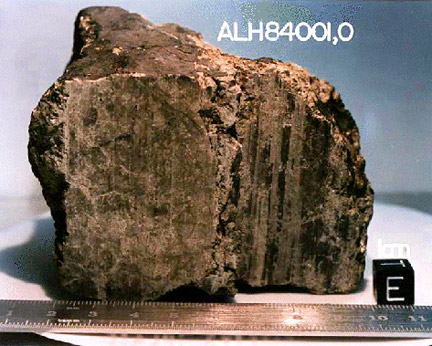While most scientists are more excited by some of the possibilities that Europa may offer, the next most likely place to find some kind of life is still Mars. Even after all the landers, rovers and orbiting observers, Mars still keeps dropping hints that there may still be some kind of rare environs in a few places where any life that may have once flourished could still have survived these many millions of years since the planet dried up. Just last week the first direct evidence of liquid water moving across its surface was presented at a special news conference based upon the observations of the now defunct Mars Global Surveyor (see wallpaper image below). Perhaps whatever small amount of underground water still exists on Mars still plays host to some simple forms of life which have adapted and learned to also go to where the water went, which seems to be underground.

Most expect that if we ever find anything hopeful on Mars it will be in the form of a fossilized record. Many doubt that life on Mars is current and the assumption is that the odds are highly in favor of Mars having once been a habitable place many, many years ago when it was much wetter. There is a huge amount of evidence on that presents us with what looks like a once saturated landscape of rivers, lakes and even oceans. Had this been the case, it seems very likely that Mars may have once given rise to life on its surface and if it did – there would likely be a vast geological record of these organisms left behind.

In a related story… once in a while an Antarctic meteorite remnant is found that turns out to be one of a very rare kind which scientists are now sure are of Martian origin (they have 12 of these actually). They know this because when they drill into these meteors and find small bubbles of gas exist (as they do in most rocks) that contain almost the same exact composition of gasses that are found in the atmosphere on Mars. Leaving us with the conclusion that they must be of Martian origin as the coincidental likelihood of a rock left over from the formation of the Solar System having trapped gasses which exactly match that of the Martian atmosphere is extremely thin – if not impossible. The theory goes that some colossal impacts took place on Mars which scattered debris largely on the surface, but left a few chunks flying so fast and furious at the right speeds that they not only escaped the Martian atmosphere, but even the gravitational pull of Mars itself. Whereas they are left to wander the solar system for potentially millions of years until a chance encounter with the Earth results in an all-natural cosmic sample return mission from Mars.
 In the 90’s a paper was published in Science magazine that proposed the discovery of the first organic compounds to be found in a Martian meteorite. Furthermore, the authors of this paper observed that there may be mineralogical features that may be fossil evidence of ancient Martian organisms (see left). Excitement on this finding was high and the impact of its meaning went as high as the President of The United States making a specific statement on it at a news briefing, after all, it would be the first evidence of life outside of Earth to have ever been detected. Since that exciting time, many scientists have come out to refute each of the individual findings and have stated that they each could have each come from processes which were non-biological. However, the paper’s authors still contend that circumstances are far too coincidental and that “when considered collectively… we conclude that [these phenomena] are evidence for primitive life on early Mars”.
In the 90’s a paper was published in Science magazine that proposed the discovery of the first organic compounds to be found in a Martian meteorite. Furthermore, the authors of this paper observed that there may be mineralogical features that may be fossil evidence of ancient Martian organisms (see left). Excitement on this finding was high and the impact of its meaning went as high as the President of The United States making a specific statement on it at a news briefing, after all, it would be the first evidence of life outside of Earth to have ever been detected. Since that exciting time, many scientists have come out to refute each of the individual findings and have stated that they each could have each come from processes which were non-biological. However, the paper’s authors still contend that circumstances are far too coincidental and that “when considered collectively… we conclude that [these phenomena] are evidence for primitive life on early Mars”.
The jury is still out.